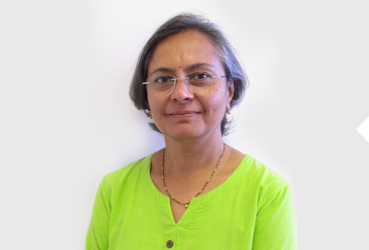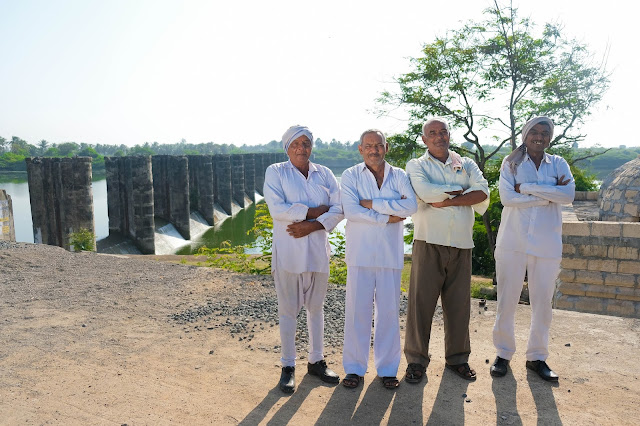Anagha Mahajani - GM, Program Research & Monitoring at ACF has over 25 years' experience in the development sector and is a qualified management and research practitioner with publications to her credit. Thrive caught up with Anagha to understand how Monitoring & Evaluation works in the context of Enabling People and Prosperity
Thrive: Why is measuring success important in the context of 'Enabling People'?
Anagha: From an earlier philanthropic mode, the sector has moved to a strategic community development mode which is a complete change in the approach towards work. As such, besides 'what' you do; 'how' you do it and 'what it results in (outputs)' are some important aspects that get considered while approaching the work. The sense of accountability has increased for every rupee that is invested in community development. Community development is now looked at with the need to have a return on investment. This is an impactful way of looking at community development since it looks at clearly fixing responsibility on the team that engages in the development work. At ACF the focus is not on doling out material benefits but creating an enabling environment for the locals to own the process of development. Measuring processes and the outputs of the initiatives highlight the change brought about in the community. Processes, when imbibed by the community, stays with them forever.
Thrive: How does ACF approach 'Enabling People'?
Anagha: When we talk about 'Enabling People', we do not just build the capacity of the people to solve problems but first help them identify and prioritise their issues. Our needs assessment process focuses on identifying the most pressing issue, addressing which, creates sustainable impact.
Once the key issue has been identified, attention shifts to building capacities of people to address and resolve the issue with specific skills. For example, in livelihoods, a real need may be realised that unemployed youth and school dropouts need employment. Consequently, they need to be equipped with skills that are vocational through a skilling centre which offers a set of skills that enables them to be differentiated from others around for possible employment opportunities. The skilling centre itself will not offer jobs but will build skills in youth that helps them find a decent & dignified livelihood and help them identify jobs where they can apply. This is a sustainable approach.
Thrive: What are the various dimensions that one needs to look at, when looking at measuring success in 'Enabling Communities'?
Anagha: All our interventions cut across social, economic & environmental dimensions. For example, when one is looking at R.O. water availability in villages, it is not bringing the technology to the village that is unique about ACF's approach but the social mobilisation around the issue. Our approach influences social systems and economic gains are achieved as better water means better health and more productivity in jobs & education. Environmentally also, water usage is optimised as the wastewater is minimised and used.
Another example is the Better Cotton Initiative (BCI) project. Farmers are provided with information and knowledge about practices and clear advice on what to do or what not to do in terms of optimising use of pesticides, seeds, fertilisers, and other inputs. This is done through social mobilisation of the farmers to get together into groups and collectively work on best practices to grow cotton. On the economic front as inputs are lesser, costs are lower and on the environmental front, inputs used are good for the soil and the crop, which leads to sustainable farming.
Thrive: Which approach does ACF subscribe to, when looking at measuring success in 'enabling people' and what are some of the indicators you would use for measurement?
Anagha: We have moved from an input-based monitoring system to an output-based monitoring system. If we take the example of a check dam, earlier we would look at the money that has gone into building the check dam. Over time, we realised that building a check dam is not what is unique to ACF. What is unique to ACF is the process - engaging the local community prior to building the check dam, engaging other stakeholders including the government, other CSR organisations, investors and making it a collaborative process for all. This is not captured when one simplistically looks at measures such as number of check dams built.
The approach is, however, differentiated when one starts looking at outputs - What is the change we were able to effect because of building the check dam? Does the check dam exist today, Is it being maintained properly by the community through the Water User Associations we created, Is the water being used by the community, how much water has been accumulated etc...The outputs cannot be measured only with quantitative indicators. Community ownership & stakeholder engagement can be measured only using qualitative indicators. Across our 6 major programs we have over 1300 indicators on which data is reported regularly.
An output-based system considers the inputs but focuses more on capturing the resulting change. The indicators captured provide a long-term perspective on change brought about in the community, paving the way for sustainable impact. This differentiates ACF from many other organisations in the space.
Over a period, we realised that we also need to capture evidence- not to miss out on the prior situation, and data to scientifically articulate the change brought about through ACF intervention. For this, a baseline survey is now initiated for any project that ACF takes up.
In the context of impact evaluation, which is usually done after at least 5 years of project completion, ACF uses different approaches including conducting SROI which captures changes occurred from the stakeholder's perspective. This clearly articulates the value derived for every rupee spent in the project.
For Impact Evaluation, we would bring in an external agency to evaluate our performance. For example: IFMR did an impact evaluation of micro-irrigation in Kodinar, Gujarat.
The space, however, is an evolving one and there are always newer methodologies that enable us to measure better.
Thrive: How is the 'Monitoring & Evaluation' function structured at ACF?
Anagha: Our founders have always thought ahead of time. Their keen interest in undertaking serious efforts for the prosperity of the community and measuring the change translated into setting up a focused vertical with a professional approach. At ACF, monitoring is integral to implementation and is undertaken by the team itself. This is vis-Ã -vis having independent team for monitoring & evaluation. Our approach, allows for self-reflection, connecting with stakeholders for their feedback and a focus on doing better each time. This, I believe, is a more sustainable approach to effective monitoring & evaluation.
Thrive: When working with partner investors, do the approaches towards monitoring & evaluation differ?
Anagha: Yes, they do but the scope of our monitoring system is so comprehensive that we can feed into any other organisation's monitoring system. Every quarter, from each location, 1300 data indicators are logged in across our 6 programs. Each program itself is huge & is constituted of multiple projects. For example: Agriculture is made up of KVK, BCI, SRI, Organic farming, and agriculture allied livelihoods like goatery and poultry.
Thrive: What would be some of the initiatives at ACF, that you would rate highly on effectiveness in enabling people?
Anagha: In the recent past, placement meets at SEDI has been a remarkably successful initiative. Our monitoring of the programme helped us identify that direct communication with partners will go a long way in helping us both improve the quality of the courses and increase chances of sustainable livelihoods for the students. In Agriculture, our effort for marketing organic farm produce through FPOs in Roorkee has been highly effective. In our program in women, the Sorath Women's Federation that ACF supports in Kodinar, Gujarat has been instrumental in addressing social issues in the region, creating lasting change. the ACF supported women's federation in Darlaghat, Himachal Pradesh has been successful in creating livelihoods through their dairy initiative. In the health domain, awareness initiatives around COVID-19 in our supported regions were enabled with a quick turnaround time. All these initiatives have had long lasting change among the communities we work with. Given the wealth of experience and knowledge in ACF, we have actively started looking at Knowledge Sharing as well. It has been well appreciated by corporates, especially the ones just entering the field post the legal mandate for CSR. These knowledge sharing forums and events add immense value to the participating organisations.









0 Comment